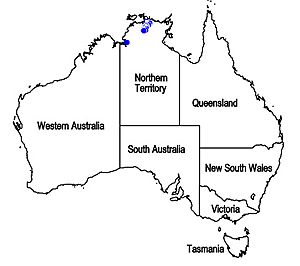Pityrodia jamesii facts for kids
Quick facts for kids Pityrodia jamesii |
|
|---|---|
| Scientific classification | |
| Genus: |
Pityrodia
|
| Species: |
jamesii
|
 |
|
| Where this plant grows in Australia | |
Pityrodia jamesii is a special kind of flowering plant. It belongs to the mint family, called Lamiaceae. You can only find this plant in a place called Arnhem Land in the Northern Territory, Australia. It grows as a bushy plant, like a small shrub. Its stems are a bit hairy and yellowish-brown. The leaves can be sticky and hairy, shaped like an egg or a spear. When it blooms, it has pretty white flowers that look like tiny bells.
Contents
What Pityrodia jamesii Looks Like
Pityrodia jamesii is a bushy plant that spreads out. It can grow to be about 0.5–1.82 m (1.6–6.0 ft) tall. Its branches are covered with yellowish hairs, making them feel fuzzy.
Leaves and Stems
The leaves of this plant are shaped like a spear (lance-shaped) or like an egg (egg-shaped). When they are young, they can feel sticky. Most leaves are about 15–35 mm (0.59–1.4 in) long and 3–8 mm (0.1–0.3 in) wide. Their edges are often rolled under. The leaves grow close together near the ends of the branches. They are hairy and have special glands that make them sticky. If you look closely at the underside of the leaves, you can see raised veins.
Flowers and Fruit
The flowers grow where the leaves meet the stem, which is called the axil. They have small leaf-like parts called bracts and even smaller ones called bracteoles.
Each flower has five sepals, which are like small leaves that protect the bud. These sepals join together at the bottom to form a bell-shaped tube. The outside of this tube is hairy and has glands. The inside is smooth (glabrous).
The petals are white and measure about 8–12 mm (0.31–0.47 in) long. They are joined together for about half their length, forming a bell-shaped tube. At the end of this tube, there are five separate parts called lobes. The three lower lobes are free from each other, about 3.5–6 mm (0.1–0.2 in) long and 2–4 mm (0.08–0.2 in) wide. The two upper lobes are about 5–8 mm (0.2–0.3 in) long and 2.5 mm (0.098 in) wide, and they are mostly joined together.
Inside the flower, there are four stamens, which are the parts that make pollen. They stick out a little bit from the end of the flower tube. Two of the stamens are slightly shorter than the other two.
This plant can flower in most months of the year. After the flowers, it produces an oval-shaped, hairy fruit. The fruit is about 3–4 mm (0.12–0.16 in) long and 2.3 mm (0.091 in) wide.
How Pityrodia jamesii Got Its Name
The plant Pityrodia jamesii was first officially described in 1979 by a scientist named Raymond Specht. He found a sample of the plant on some sandstone hills near Gunbalanya, Northern Territory. This happened during a big science trip called the "American-Australian Scientific Expedition to Arnhem Land" in 1951.
The description of the plant was published in a book about the expedition's findings. The second part of the plant's scientific name, jamesii, was chosen to honor Stewart James. He helped collect plant samples and was an expert in farming.
Where Pityrodia jamesii Lives
You can find Pityrodia jamesii in Arnhem Land, especially near the East and South Alligator Rivers. This area is in the Northern Territory of Australia.
Protecting Pityrodia jamesii
Good news! Pityrodia jamesii is currently classified as "least concern." This means that there are enough of these plants in the wild, and they are not in danger of disappearing anytime soon. This classification is made under the rules of the Territory Parks and Wildlife Conservation Act 2000.

